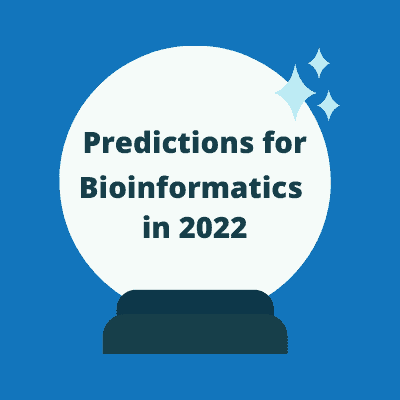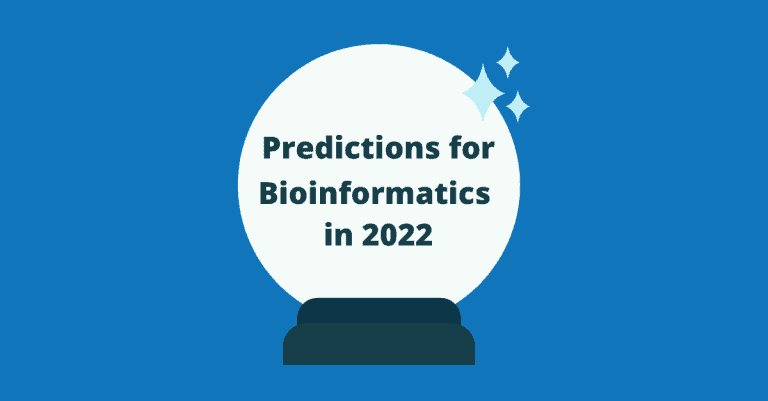Bioinformatics 2022: Our Predictions
- 6th January 2022
- Posted by: Breige McBride
- Categories: Bioinformatics, News

What would a bioinformatician predict about bioinformatics in 2022? In short, a lot of changes. We asked our Fios team what their predictions are for bioinformatics in 2022, and they had plenty to say! Read their predictions below.

Bioinformatics 2022: Key Predictions
Use of Single-Cell Sequencing Technologies Will Increase
This was top-of-mind for a few of our bioinformaticians due to the increase in single-cell analysis projects at Fios Genomics in 2021. In fact, one bioinformatician highlighted that when it comes to single-cell analysis; we have noted a marked increase in the number of researchers who are now generating their own data rather than relying on public domain data.
Public Domain Data Will Come Into Its Own
Despite the increase we have seen in the use of single-cell sequencing, our bioinformaticians predict an overall shift from data generation to mining of public domain data. They predict this shift because of the ongoing impact of COVID-19 and the disruption it is causing for clinical trials. What’s more, given the vast amount of public domain data available; we predict that as more researchers become aware of the available datasets and how to access them, public data mining will continue to rise in popularity, regardless of the impact of COVID-19 on data generation.
The Rise of Biobanks
If overall reliance on public domain data will rise in 2022, it makes sense to expect a knock-on effect in the use of biobanks. Our bioinformaticians predict an increased focus on large-scale biobanks, especially to investigate COVID-19 related topics. In particular, we predict a shift in the use of genome-wide association studies (GWAS). While these are mainly used for research into complex diseases; in 2022 we expect to see more of these studies focusing on human-pathogen interactions.
New and Refined Methods Focusing on the Immune System
As clinical trials for immune-related therapies in cancer continue to increase, it would make sense to see more of a focus on the immune system in 2022. Various techniques for the prediction of the immune composition of tumours from bulk data have been developed in the last couple of years so we expect we will continue to see a refinement of these methods.
Our bioinformaticians have also noted that cancer trials increasingly include in their outcomes the collection of genomic-scale data at multiple levels, and attempt to integrate these for improving prediction of prognosis or response to treatment. Given this, it would be unsurprising to see methods for tracking immune development over time, such as sequencing of T-cell receptors to track clonotypes, growing in popularity for collection in cancer trials.
Epigenetics Research Will Become More Popular
Human genome research has traditionally focused on the coding regions of the genome. However, this disregards up to 99% of the whole genome. Since these regions contain important regulatory elements that control gene expression, and scientists are becoming more aware of their importance in human diseases, we expect to see an increased focus on epigenetics research in 2022.
More Virology and Vaccine Research
It goes without saying that we expect an increasing amount of research in these areas due to the ongoing pandemic. But we decided to say it anyway!
Bioinformatics 2022: Challenges
While above we predict the increased use of certain technologies and the emergence of new ones; there will also be challenges to overcome for bioinformatics in 2022.
Data integration
The main challenge our bioinformaticians predict in bioinformatics this year isn’t a new one: data integration. It has always been challenging to combine data from different sources. However, when data integration is successful it can be extremely beneficial. For example, by unifying the view of impact from a drug through integration of multiple data types, we can gain comprehensive understanding of its effect on a biological system. At Fios Genomics, we have a unique understanding of the benefits of data integration and pride ourselves on our data integration capabilities.
Data integration is a common problem in data science. It will likely always be an issue to a greater or lesser extent. In bioinformatics, combining different datasets would be made easier by the adoption of a common set of gene/protein IDs. However, this is unlikely to happen as it would require either the European Bioinformatics Institute (EBI) or the National Center for Biotechnology Information (NCBI) to cede authority to the other. Due to the friendly but real rivalry between the USA and the EU in this field, this is unlikely.
Big Data
Big data presents challenges for bioinformatics in 2022 and beyond. Analyses of large-scale datasets are required more and more. The chief difficulties here are largely logistical. For example, the challenges of genotyping and whole genome sequencing large cohorts of humans while also developing analyses that do not generate large numbers of false positives.
Data Scarcity
On the opposite end of the spectrum from big data, there is the challenge of data scarcity. A lack of samples is usually to blame for this. For example, from a clinical and experimental perspective, 100 patient-derived tumour samples is an enormous amount. However, from a machine learning perspective, where we may expect 20,000+ features, 100 samples is not even close to the amount required to produce meaningful results. Fortunately, we anticipate that clinical and experimental automation, increasing interest in machine learning and the ever lowering costs of sequencing, will help to address this challenge.
It is also important to consider the effects of the pandemic on data generation. In 2022 and 2023, the reduced data generation caused by COVID-19’s impact on wet lab work and the global supply chain will become apparent. In response, we expect companies will increasing rely on public datasets, such as those available from biobanks. Indeed, many of our clients have already made this shift to using public data to answer their research questions. This is why data mining was one of our most popular services in 2021.
Increasing Public Data Availability
While we expect bioinformatics in 2022 to be impacted by the lag in wet lab data generation caused by the pandemic, the availability of public data will only increase. Already there is a vast amount of public data sets available; so many in fact, that the challenge is often knowing what data is available and where to access it. Even still, we are glad to predict that there will be exponential growth in public data availability. In the UK in particular, many research funding bodies now require data management plans for new projects. These frequently stipulate that data should be deposited in a public repository on, or shortly after, publication.
Documentation
Unfortunately, biological data is not always properly categorised, maintained, and annotated. This means that some results from costly experiments never reach their full potential. They fail to achieve this due to missing information on how the experiment was conducted and how the related analysis was performed. To address this challenge, more unified frameworks would be helpful. Also, researchers should focus on generating samples in a uniform manner to allow for more straightforward documentation.
Conclusion
So, there you have it, our Bioinformatics 2022 predictions. Clearly, 2022 is going to be a pivotal year in the field of bioinformatics. Overall, our key prediction for this year is a large-scale shift towards utilising public datasets. This shift will be driven by the impact of the COVID-19 pandemic, the rise of biobanks, and the increasing availability of public data.
At Fios Genomics, we are able to publish this blog due to our large team of talented bioinformaticians. Our team specialise in everything from gene expression analysis to metabolomics analysis and are adept at data mining and landscaping. You can learn more about our capabilities on our bioinformatics services page. Alternatively, If you would like to discuss a project with one of our bioinformatics specialists please contact us. At Fios, we are always happy to share our bioinformatics expertise!
See Also:
Using Biobank Data to Reach Your Research Goals
Bioinformatics and the Pharmaceutical Industry
At Fios Genomics, we avoid providing clients with lists or more data. Instead, our analysis solutions provide relevant, reliable and actionable information. Our conclusions are data-driven and led by biology rather than statistics, as you can see in our data analysis report examples.
Fill the form below to receive a demo today.
Leave a Reply
You must be logged in to post a comment.

